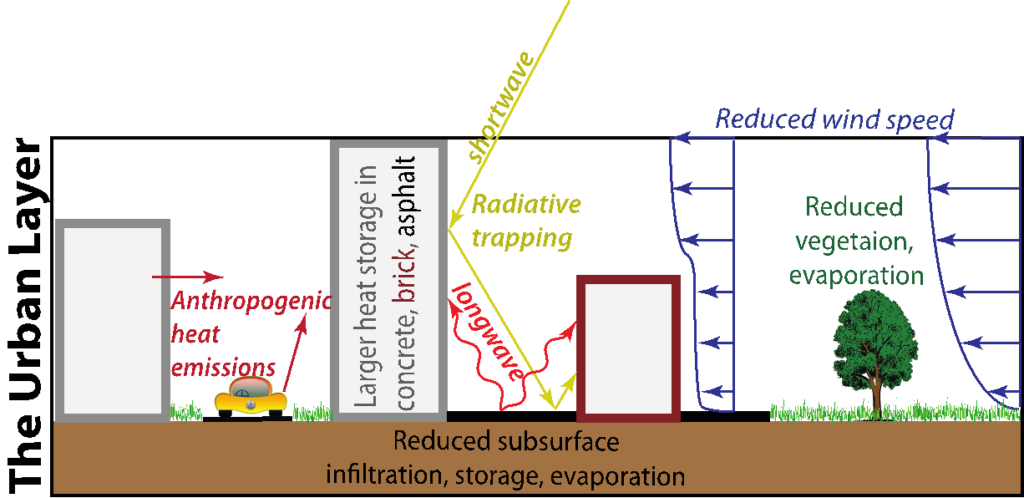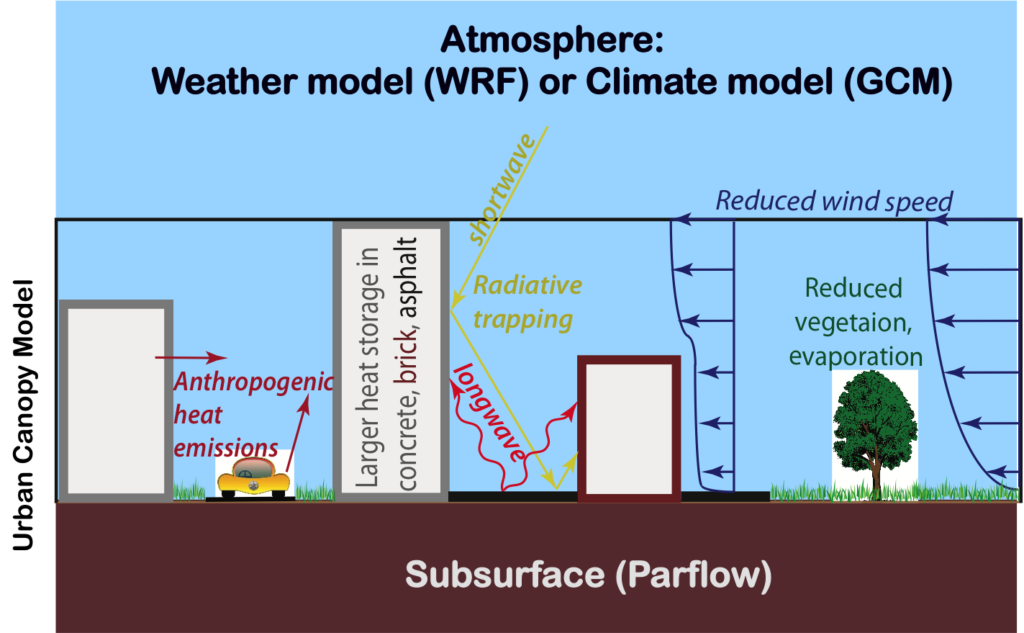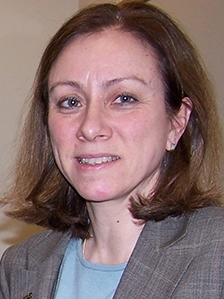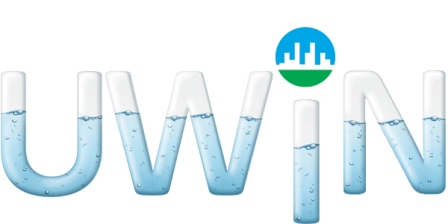Project A2-1:Land-Atmosphere-Hydrosphere Interactions in Urban Terrain
Elie Bou-Zeid, PhD – Principal Investigator
Princeton University
Civil and Environmental Engineering
Claire Welty, PhD – Co-Principal Investigator
University of Maryland, Baltimore County
Chemical, Biochemical and Environmental Engineering
The overarching aim of the project is to build the next-generation urban hydro-climatological simulation platform that will combine the state of the science in atmospheric, urban surface, and groundwater models.
Specifically, we will couple the Weather Research and Forecasting (WRF) atmospheric model with the ParFlow subsurface flow model. At the urban interface of these two domains, we will implement and further develop an Urban Canopy Model (UCM) that captures the wide range of radiative, thermodynamic, fluid dynamic, and hydrologic processes operating in urban terrain.
The new simulation platform will have capabilities that are not available in any current model. Specifically, we aim to use the new model to assess:
- Water demand and cooling impact of canyon trees
- Total urban water demand and how it is modulated by weather
- Influence of surface-groundwater coupling and decoupling on the urban microclimate
- Complex water-climate-energy repercussions of green infrastructure systems (urban irrigation, rainwater tanks, biofiltration systems, green roofs, etc.)
- Thermal comfort in the urban outdoor space.
These applications will help us better understand urban sustainability under historic extreme events (e.g., heat waves, floods, droughts) and present conditions. Furthermore, the modeling advances will also be transferred to other teams who are focusing on the impact of future extreme events, and how the cities of the future can reduce their resource use and improve their resilience and sustainability.
DATA NEEDS
The project will require current and past land use data and data for urban water and energy consumption.
DATA USE
The data will be used as input to the simulations, and to develop mitigation scenarios.
A2-1: Coupled Model
The model consists of three coupled elements:
- Weather Research and Forecasting (WRF) atmospheric model
- ParFlow subsurface flow model
- Advanced Urban Canopy Model (UCM) for the urban surface (interface between atmosphere and subsurface)
These are highly complex models that require extensive computing and skill to execute. Thus they will be shared only within the scientific community.
However, based on these models’ outputs, we could consider the development of simplified interactive tools that can help decision makers understand the benefits and consequences of certain actions and mitigation scenarios we have assessed in our work.
Book Chapters
- Llaguno-Munitxa M. and Bou-Zeid E. (2021) “Sensing the Environmental Neighborhoods: Mobile Urban Sensing Technologies (MUST) for High Spatial Resolution Urban Environmental Mapping”, in Proceedings of the 2020 DigitalFUTURES, ed. F. Yuan et al.,
https://www.doi.org/10.1007/978-981-33-4400-6_12
Journal Articles
- Barnes, M.L. and Welty, C. (2019) “Quantifying water balance components at a permeable pavement site using a coupled groundwater–surface water model” ASCE J of Hydrologic Engineering, https://doi.org/10.1061/(ASCE)HE.1943-5584.0001789
- Bradshaw, J., Bou-Zeid, E, and Harris, R.H. (2016) “Greenhouse gas mitigation benefits and cost-effectiveness of weatherization treatments for low-income, American, urban housing stocks”, Energy and Buildings, 128,911-920, DOI: 10.1016/j.enbuild.2016.07.020.
- El-Samra , Bou-Zeid E., El-Fadel M. “To What Extent Does High Resolution Dynamical Downscaling Improve the Representation of Climatic Extremes over an Orographically Complex Terrain?”, Theoretical and Applied Climatology, online, DOI 10.1007/s00704-017-2273-8
- El-Samra R., Bou-Zeid E., El-Fadel M. (2018) “What Model Resolution is required in Climatological Downscaling over Complex Terrain?”, Atmospheric Research, 203, 68–82, DOI:10.1016/j.atmosres.2017.11.030.
- El-Samra R., Bou-Zeid E., Bangalath H.K., Stenchikov G., El-Fadel M. (2018) “Seasonal and regional patterns of future temperature extremes: High-resolution dynamic downscaling over a complex terrain”, Journal of Geophysical Research – Atmospheres, 123, 6669–6689, DOI:10.1029/2017JD027500. Status = Published; Acknowledgment of Federal Support = Yes; Peer Reviewed = Yes.
- El-Samra R., Bou-Zeid E., Bangalath H.K., Stenchikov G., El-Fadel M. (2017) “Future intensification of hydro-meteorological extremes: downscaling using the weather research and forecasting model”, Climate Dynamics, 49, 3765–3785, DOI: 10.1007/s00382-017-3542-z.
- Fabiani C., Pisello A.L., Bou-Zeid E., Yang J., Cotana F. (2019) “Adaptive measures for mitigating urban heat islands: the potential of thermochromic materials to control roofing energy balance”, Applied Energy, 247, 155-170, DOI: 10.1016/j.apenergy.2019.04.020.
- Kuehni, S.M., Bou-Zeid E., Webb C., Shokri N. (2016), “Roof cooling by direct evaporation from a porous roof layer”,Energy and Buildings, 127, 512-528, DOI: 10.1016/j.enbuild.2016.06.019. Status = Published; Acknowledgment of Federal Support = Yes; Peer Reviewed = Yes.
- Lei Z., Oppenheimer M., Qing Z., Baldwin J., Ebi K., Bou-Zeid E.; Guan K., Liu X. (2018) “Interactions between urban heat islands and heat waves”, Environmental Research Letters, 13, 034003, DOI: 10.1088/1748-9326/aa9f73.
- Li Q., Bou-Zeid E., Anderson W., Grimmond S., Hultmark M. (2016) “Quality and Reliability of LES of Convective Scalar Transfer at High Reynolds Numbers”, International Journal of Heat and Mass Transfer, 102, 959–970. http://dx.doi.org/10.1016/j.ijheatmasstransfer.2016.06.093 Status = Published; Acknowledgment of Federal Support = Yes; Peer Reviewed = Yes.
- Li Q, Wang ZH (2017) Large-eddy simulation of the impact of urban trees on momentum and heat fluxes, Agricultural and Forest Meteorology, https://doi.org/10.1016/j.agrformet.2017.07.011.
- Li Q., Bou-Zeid E. (2019) “Contrasts Between Momentum and Scalar Transport Over Very Rough Surfaces”, Journal of Fluid Mechanics, 880, 32-58. DOI: 10.1017/jfm.2019.687.
- Li Q, Bou-Zeid E, Grimmond S, Zilitinkevich S, Katul G (2020) “Revisiting the Relation Between the Momentum and Scalar Roughness Lengths of Urban Surfaces”, Quarterly Journal of the Royal Meteorological Society, 146, 3144 -3164, DOI: 10.1002/qj.3839.
- Lim, T. C. and Welty, C. (2018) “Assessing variability and uncertainty in green infrastructure planning using a high-resolution surface-subsurface hydrological model and site-monitored flow data”. Frontiers of the Built Environment, https://doi.org/10.3389/fbuil.2018.00071
- Llaguno-Munitxa M., Bou-Zeid E., Hultmark M. (2017) “The influence of building geometry on street canyon air flow: validation of large eddy simulations against wind tunnel experiments”, Journal of Wind Engineering & Industrial Aerodynamics, 165, 115-130. https://doi.org/10.1016/j.jweia.2017.03.007
- Llaguno-Munitxa M. and Bou-Zeid E. (2018) “Shaping buildings to promote street ventilation: a large-eddy simulation study”, Urban Climate, 26, 76-94, DOI: 10.1016/j.uclim.2018.08.006. Status = Published; Acknowledgment of Federal Support = Yes; Peer Reviewed = Yes.
- Llaguno-Munitxa M. and Bou-Zeid E. (2020) “The environmental neighborhoods of cities and their spatial extent”, Environmental Research Letters, 15, 074034, DOI: 10.1088/1748-9326/ab8d7e
- Malings C., Pozzi M., Klima K., Bergés M., Bou-Zeid E., Ramamurthy P. (2017) “Surface Heat Assessment for Developed Environments: Probabilistic Urban Temperature Modeling”, Computers, Environment and Urban Systems, 66, 53-64, DOI: 10.1016/j.compenvurbsys.2017.07.006.
- Malings C., Pozzi M., Klima K., Bergés M., Bou-Zeid E., Ramamurthy P. (2018) “Surface Heat Assessment for Developed Environments: Optimizing Urban Temperature Monitoring”, Building and Environment, 141, 143-154, DOI: 10.1016/j.buildenv.2018.05.059.
- Manoli G., Fatichi S., Bou-Zeid E. and Katul G.G. (2020) “Seasonal hysteresis of surface urban heat islands”, Proceedings of the National Academy of Sciences, 201917554; DOI: 10.1073/pnas.1917554117.
- Manoli G., Fatichi S., Schläpfer M, Yu K., Crowther T.W., Meili N, Burlando P., Katul G.G., and Bou-Zeid E. “Magnitude of urban heat islands largely explained by climate and population”, Nature, 573, 55–60. DOI: 10.1038/s41586-019-1512-9.
- Omidvar H. and Bou-Zeid E. (2019) “Hacking a soil water content reflectometer to measure liquid level”, Flow Measurement and Instrumentation, 65, 174-179, DOI: 10.1016/j.flowmeasinst.2018.11.014.
- Omidvar H., Bou-Zeid E., and Chiaramonte M. (2019) “Physical determinants and reduced models of the rapid cooling of urban surfaces during rainfall”, Journal of Advances in Modeling Earth Systems, 11, 1364-1380, DOI: 10.1029/2018MS001528.
- Omidvar H., Song J., Yang J., Arwatz G., Wang Z.-H., Hultmark M., Kaloush K., Bou-Zeid E. (2018) “Rapid Modification of Urban Land Surface Temperature during Rainfall”, Water Resources Research, 54, 4245-4264, DOI: 10.1029/2017WR022241.
- Omidvar, H., Bou-Zeid, E., Li, Q., Mellado, J., & Klein, P. (2020). Plume or bubble? Mixed-convection flow regimes and city-scale circulations. Journal of Fluid Mechanics, 897, A5. DOI:10.1017/jfm.2020.360
- Pigliautile I, Pisello A. L., and Bou Zeid E (2020) “Humans in the city: representing outdoor thermal comfort in urban canopy models”, Renewable & Sustainable Energy Review, 133, 110103, DOI: 10.1016/j.rser.2020.110103
- Ramamurthy, P., & Bou‐Zeid, E. (2016). Heatwaves and Urban Heat Islands: A Comparative Analysis of Multiple Cities Using a High‐Resolution Numerical Model. Journal of Geophysical Research: Atmospheres. https://doi.org/10.1002/2016JD025357. Status = Published; Acknowledgment of Federal Support = Yes; Peer Reviewed = Yes.
- Ryu, Y.-H., J. A. Smith, M. L. Baeck and E. Bou-Zeid, The influence of land-surface heterogeneities on heavy convective rainfall in the Baltimore-Washington metropolitan area, Monthly Weather Review, 144, 553–573, 2016. http://dx.doi.org/10.1175/MWR-D-15-0192.1 Status = published. Acknowledgement = yes. Peer-reviewed =yes.
- Shim, S., Shin, S., Meggers, F., Bou-Zeid, E., & Stone, H. A. (2016). Controlled evaporative cooling on a superhydrophilic surface: building a green wall. In Bulletin of the American Physical Society (Vol. 61–20). Portland, Oregon. Retrieved from http://meetings.aps.org/Meeting/DFD16/Session/R2.6
- Shokri Kuehni, Salomé M.S. Elie Bou-Zeid, Colin Webb, Nima Shokri (2016). Roof cooling by direct evaporation from a porous layer, Energy and Buildings 127: 521-528, https://doi.org/10.1016/j.enbuild.2016.06.019
- Song, J. and Wang, Z.-H (2016).: Evaluating the impact of built environment characteristics on urban boundary layer dynamics using an advanced stochastic approach, Atmos. Chem. Phys., 16, 6285-6301, https://doi.org/10.5194/acp-16-6285-2016,
- Song J, Wang ZH (2016), Diurnal changes in in urban boundary layer environment induced by urban greening, Environmental Research Letters, 11: 114018. http://dx.doi.org/10.1088/1748-9326/11/11/114018
- Song J, Wang ZH, Wang C (2017), Biospheric and anthropogenic contributors to atmospheric CO2 variability in a residential neighborhood of Phoenix, Arizona, Journal of Geophysical Research: Atmospheres, 122:3317-3329. https://doi.org/10.1002/2016JD026267
- Sun T, Wang ZH, Oechel W, Grimmond CSB (2017) The analytical objective hysteresis model (AnOHM v1.0): Methodology to determine bulk storage heat flux coefficients, Geoscientific Model Development, 10: 2875-2890, https://doi.org/10.5194/gmd-10-2875-2017
- Talebpour M., Welty C., Bou-Zeid E. (2021) “Development and testing of a fully-coupled subsurface-land surface-atmosphere model: high-resolution application in urban terrains”. Urban Climate, https://doi.org/10.1016/j.uclim.2021.100985
- Teitelbaum E, Meggers F., Scherer G., RamamurthY P., Wang L., Bou-Zeid E. (2015). ECCENTRIC Buildings: Evaporative Cooling in Constructed ENvelopes by Transmission and Retention Inside Casings of Buildings. Energy Procedia 78:1593-1598. https://doi.org/10.1016/j.egypro.2015.11.218
- Wang ZH, Fan C, Myint SW, Wang C (2016) Size matters: what are the characteristic source areas for urban planning strategies? PLoS One, 11(11):e0165726. http://dx.doi.org/10.1371/journal.pone.0165726
- Wang C, Wang ZH (2017), Projecting population growth as a dynamic measure of regional urban warming, Sustainable Cities and Society, 32: 357-365. https://doi.org/10.1016/j.scs.2017.04.010
- Wang ZH, Li Q (2017), Thermodynamic characterisation of urban nocturnal cooling, Heliyon, 3: e00290. https://doi.org/10.1016/j.heliyon.2017.e00290
- Wang, W., J. A. Smith, P. Ramamurthy, M. L. Baeck, E. Bou-Zeid and T. M. Scanlon, On the correlation of water vapor and CO2: application to flux partitioning of evaporation, Water Resources Research, 52, 9452–9469, doi:10.1002/ 2015WR018161, 2016. https://doi.org/10.1002/2015WR018161
- Yang J. and Bou-Zeid E. (2019) “Designing sensor networks to resolve spatio-temporal urban temperature variations: fixed, mobile or hybrid?”, Environmental Research Letters, 14, 074022, DOI: 10.1088/1748-9326/ab25f8.
- Yang J. and Bou-Zeid E. (2018) “Should cities embrace their heat islands as shields from extreme cold?” Journal of Applied Meteorology and Climatology, 57, 1309–1320,, DOI: 10.1175/JAMC-D-17-0265.1.
- Yang J, Wang ZH, Georgescu M, Chen F, Tewari M (2016) “Assessing the impact of enhanced hydrological processes on urban hydrometeorology with application to two cities in contrasting climates”. Journal of Hydrometeorology, 17, 1031-1047, DOI:10.1175/JHM-D-15-0112.1
- Yang J. and Bou-Zeid E. (2019) “Scale dependence of the benefits and efficiency of green and cool roofs”, Landscape and Urban Planning, 185, 127-140, DOI: 10.1016/j.landurbplan.2019.02.004.
- Zahn E. ,Welty C., Smith J., Kemp S., Baeck M.-L. & Bou-Zeid E. (2021) “The Hydrological Urban Heat Island: Determinants of Acute and Chronic Heat Stress in Urban Streams”. Journal of the American Water Resources Association, https://doi.org/10.1111/1752-1688.12963.
- Zhao, Lei, Oppenheimer M., Qing Z., Baldwin J., Ebi K., Bou-Zeid E.; Guan K., Liu X. (2018) “Interactions between urban heat islands and heat waves”, Environmental Research Letters, 13, 034003, DOI: 10.1088/1748-9326/aa9f73.
- Zhao L., Oleson K., Bou-Zeid E., Krayenhoff E.S., Bray A., Zhu Q., Zheng Z., Chen C., and Oppenheimer M. (2020), “Global multi-model projections of local urban climates”, Nature Climate Change, 11, 152–157, https://doi.org/10.1038/s41558-020-00958-8
Updated: October 2022
Dissertations
Yang, Jiachuan (2016) “Urban Green Infrastructure: Modeling and Implications to Environmental Sustainability”, PhD Dissertation, Arizona State University, Tempe, AZ.
Li, Qi (2016) “Scalar and Momentum transport over Complex Surfaces”, PhD Dissertation, Department of Civil and Environmental Engineering, Princeton University, Princeton, NJ.
Related Materials
Additional Resources
 Elie Bou-Zeid, PhD – Principal Investigator
Elie Bou-Zeid, PhD – Principal Investigator
Associate Professor
Civil and Environmental Engineering
Princeton University
Voice: (609) 258-5429
Email: ebouzeid@princeton.edu
Dr. Bou-Zeid’s current research specifically focuses on combining numerical, experimental, and analytical tools to study the basic dynamics of flow and transport in environmental systems. The aim is to study how Environmental Fluid Mechanics relate to problems in climate change, air quality, hydrology, and sustainable development.
 Claire Welty, PhD – Co-Principal Investigator
Claire Welty, PhD – Co-Principal Investigator
Professor
Chemical, Biochemical and Environmental Engineering
University of Maryland, Baltimore County
Voice: (410) 455-1766
Email: weltyc@umbc.edu
Our interest is in developing an end-to-end system of field-deployed sensors and fully coupled groundwater-surface water mathematical models to quantify and predict the urban hydrologic cycle and coupled biogeochemical cycles from neighborhood to regional scales. Our goal is to be able to assimilate sensor data into hydrologic and water quality models in near-real time for predicting flow paths, fluxes and stores of water and chemicals on land surfaces and in the subsurface. We work in collaboration with the NSF Baltimore Ecosystem Study Long-Term Ecological Research Site and the USGS MD-DE-DC Water Science Center. While methods are being developed using place-based research in Baltimore area, the methods are widely applicable to other urban areas.
Zhihua Wang, Assistant Professor
Arizona State University
Email: zhwang@asu.edu
Jiachuan Yang, Postdoctoral Fellow
Princeton University
Email: jiachuanyang@gmail.com
Hamidreza Omidvar, Ph.D. student,
Princeton University
Email: homidvar@princeton.edu
Mahdad Talebpour, Ph.D. student
University Maryland, Baltimore county
Email: mahdad1@umbc.edu
Chenghao Wang, Ph.D. student
Arizona State University
Email: cwang210@asu.edu
